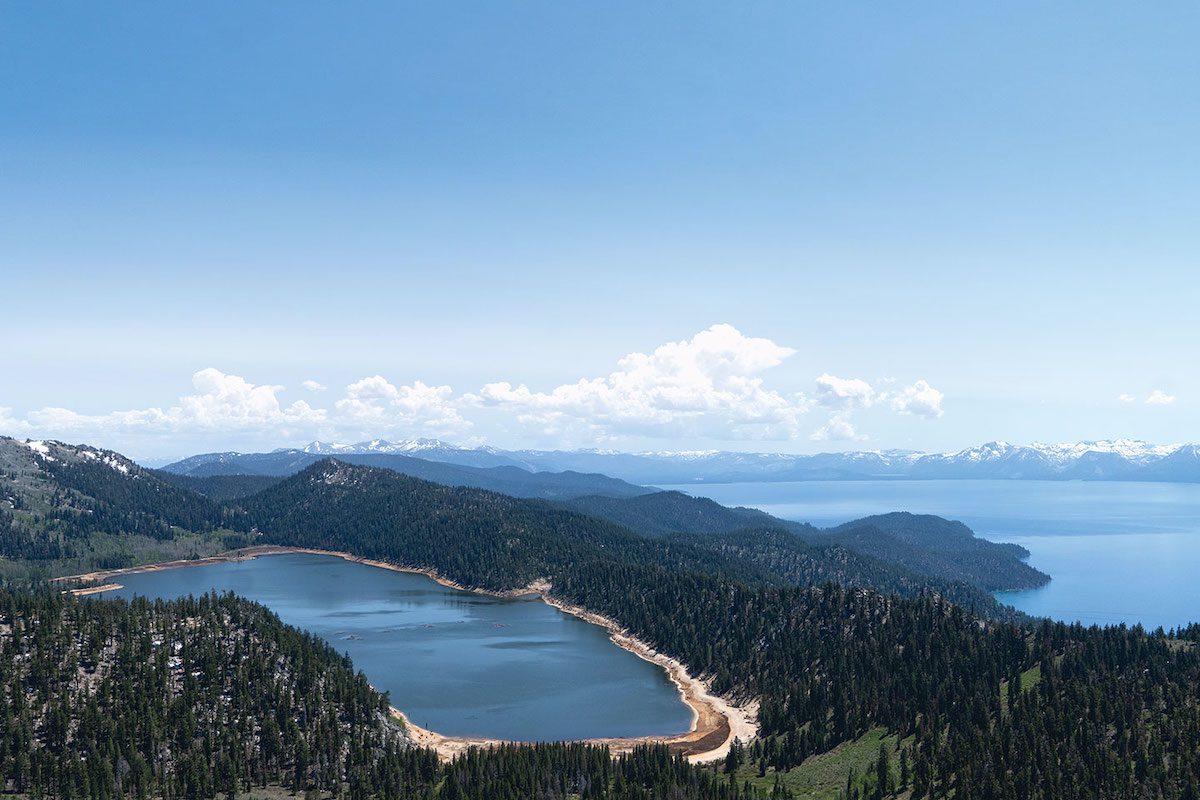
02 Jul Marlette Lake Takes a Break
A treasured recreation destination, fishery and municipal water resource above Tahoe’s East Shore goes offline for a dam repair project
If there’s one thing hikers, mountain bikers, anglers, equestrians, and even regional water and wildlife managers can all agree on, it’s the stunning beauty and value of Marlette Lake.
Perched 1,600 feet above Lake Tahoe’s East Shore, just south of Sand Harbor, Marlette Lake is a hidden jewel whose impact as both a recreation destination and municipal resource dwarfs its relatively small size. The 2-mile-long, half-mile-wide sparkling blue water body is actually a reservoir created in 1873 by a logging company that dammed a creek and put the water to work moving timber down to Carson City. By 1876, the little lake was working double duty, as it also became the linchpin in an ingenious delivery system that provides water to Virginia City and Carson City to this day.
Beyond Marlette’s hard-working history, the lake is now one of the centerpieces of a vast network of multiuse trails in Lake Tahoe – Nevada State Park. Hundreds of people hike, pedal or ride horses to the lake every year to swim, fish, see fall colors and connect with popular trails.
That is, until this year.
After nearly 150 years on the job, Marlette Lake and all the trails accessing it are closed to the public until fall 2026 for a dam repair project. The earthen dam has been deemed high risk for failure in the event of a major earthquake. So to protect visitors, the water quality of Lake Tahoe and the water system that relies on it, Marlette Lake is finally taking a well-deserved break.
From Marlette Lake to the Faucet
The rocks and dirt at the foundation of the Marlette Lake Dam were laid in 1873 by the Carson Tahoe Lumber and Fluming Company, owned by lumber magnate Duane Bliss and railroad czar Henry Yerington. Bliss and Yerington built a 26-foot-high dirt-filled rock dam that replaced a primitive dam and created a much larger reservoir known at the time as Lake Goodwin.
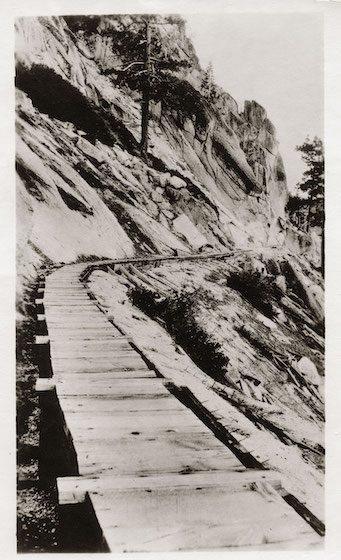
The original wooden box flume that ran water from Marlette Lake to Tunnel Creek, photo courtesy Nevada Historical Society
In 1876, the dam was raised to 37 feet when the Virginia City & Gold Hill Water Company agreed with the lumber company to draw water from the lake and deliver it to Virginia City and the booming Comstock mines via a groundbreaking inverted siphon system, which they had constructed just over the ridge at Hobart Reservoir in 1873.
This gravity-fed system was a nineteenth-century engineering marvel, as its hand-forged, 11-inch-diameter steel piping could withstand higher water pressure than any other pipes in the world.
Using principles of fluid dynamics alone, the pipes dropped crystal-clear Sierra water 2,000 vertical feet to the Washoe Valley floor before pushing it back up 1,500 feet to the crest of the Virginia Range. To move the water from Marlette Lake to the head of the siphon pipe, they built a network of wooden box flumes that traversed north along the west slope of the range before entering a 3,994-foot-long tunnel that bored through to the east side of the mountain.
At its peak in the 1890s, the water system employed 46 miles of box flume, 21 miles of pipeline, a nearly mile-long tunnel, four reservoirs and six maintenance stations. It supplied 10 million gallons of water a day to the Comstock.
While the water demands these days are much lower, the system remains fully operational and continues to supply 2 million gallons of fresh alpine water a day to Virginia City, Storey County and parts of Carson City using some of the original steel piping.
The tunnel and flume network on the west slope are gone though. The tunnel collapsed in 1957 and the flume grade was repurposed in the 1980s to create the Marlette Flume Trail, one of Tahoe’s most popular and scenic mountain bike trails. A natural gas–powered pump is now used to draw water from Marlette Lake when necessary.
“We only pump out of Marlette in July, August and September, the peak demand months,” says Blake Gudmundson, water system manager for Nevada’s State Public Works Division.
During non-peak months, the water system pulls from Hobart Reservoir and springs on the east slope of the Carson Range.
Fix it Before it Fails
“It’s time—time to rebuild,” says Gudmundson. “Yes, the dam is historic, but you have to look at what the potential effects a catastrophic failure would have.”
The U.S. Army Corps of Engineers recently rated the 150-year-old structure as a “High Hazard Dam”, which led the U.S Department of Homeland Security to award the repair project a $10 million FEMA grant. The state of Nevada has budgeted $13.4 million for planning and construction in addition to the grant.
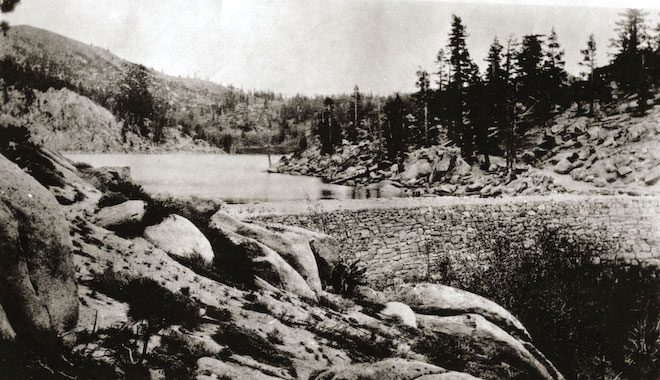
Marlette Lake Dam in the 1930s, photo courtesy Nevada Historical Society
The “high hazard” rating stems from inspections of the dam that indicate a high probability of failure should the region experience a 6.5 magnitude earthquake or greater. Seepage at the toe of the dam has been noted, a sign that water already found a way under the dam. A big quake could easily turn these slowly leaking water channels into a raging waterway.
If that were to occur, a torrent of water would rush down Marlette Creek, flood Nevada State Route 28 and likely damage a sewer pipe that runs under the highway. Beyond the potential of cars being washed off the road, thousands of gallons of sewage could end up cascading into Lake Tahoe.
“The safety of the dam is the biggest concern,” says Jason Crosby, project manager with the Nevada State Public Works Division. “Seismically, it really needs to be upgraded. We’re finding that seepage is becoming a problem, and the outlet pipes are corroding. The new dam will address all those issues.”
Meeting current safety standards will require extending the downstream edge of the dam by 48 feet. Unlike the original dam that incorporated rocks and soil from the surrounding area, the new embankment is being built with imported materials. The height of the dam will remain at 45 feet.
Replacing the corroded outlet pipes required draining the lake to 25 feet below the spillway, while a cofferdam will be used to hold back the remaining water from the construction site. In addition to swapping out the outlet pipe, the existing spillway will be replaced with a new concrete box culvert and spillway that is less prone to clogging.
Simultaneously, improvements are scheduled for the east slope water collection system that draws from Hobart Reservoir and the seven spring catchments upslope from it. Hobart Reservoir’s dam, which has also been deemed a high hazard, is slated for a rebuild starting in May 2026.
Let the Project Begin
Marlette Lake was drained to a depth of 20 feet in April, which permitted the contractor, Granite Construction, to begin work in May.
“We want to complete the majority of the Marlette dam project this summer,” says Crosby. “We hope to have all the earthwork and the construction of the outlet pipe and spillway done by October.”
The lake will remain closed to the public into 2026 to allow construction crews to return next summer and complete the work. The exact date of the reopening has yet to be determined, says Crosby: “I don’t want to make any promises on a reopening date. We want to get as much done as we can this year, but you never know how things will go.”
Finishing the dam reinforcements this summer is a high priority, as it will allow the lake to begin refilling with snow runoff in the spring, and a return to the previous lake level will take years.
“We’ve done a lot of studies, and the lake recharges at a rate of about 3 feet per year,” says Crosby. “So, we’re looking at about six or seven years before it will be back at the original level.”
Preserving a Prized Fishery
Travis Hawks hopes to see Marlette Lake refill as fast as possible. As the Nevada Department of Wildlife’s (NDOW) western region fisheries supervisor, Hawks oversees the Marlette fishery and broodstock program and understands the lake’s ecology as well as anyone.
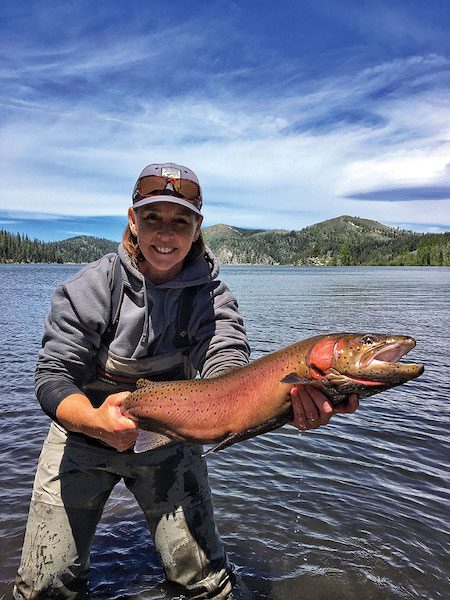
A healthy Lahontan cutthroat trout from Marlette Lake, photo courtesy NDOW
Marlette’s fishing history dates to 1877, when brook trout were first introduced as a food source and to help clear out freshwater shrimp that were clogging pipes in the water system. By the late 1880s, the water company had established a commercial fishery at Marlette to cater to the popularity of trout at dinner tables in Virginia City.
Marlette Lake is now home to three species of fish, rainbow trout, Lahontan cutthroat trout and brook trout, and is open to the public for catch-and-release fishing. NDOW also operates a broodstock program on the lake and stocks it with year-old rainbow and cutthroat every summer. Hawks and his team then return the following spring to collect eggs from the 2-year-old fish as they spawn. The eggs are transported to hatcheries, where they are reared and used to stock lakes and ponds throughout Nevada.
NDOW last stocked Marlette in 2023 knowing the dam project would begin in 2025. The 6,000-plus fish they stocked provided all the eggs for Nevada’s hatcheries in 2024.
“When the dam project was initially proposed, the plan was to drain the lake entirely,” says Hawks. “We pushed the need to keep a level of water to hopefully save the fishery. That’s what led to the decision to keep 20 feet of water in the lake.”
In the winter of 2021-22, Hawks monitored oxygen levels to see if the lake would stratify to the point that fish couldn’t survive.
“The results of the study were pretty promising,” he says. “So, we’re hopeful that 20 feet of water is enough, but there are a lot of other factors that we don’t have control over.”
A hard winter with cold temperatures and deep snow would not benefit the fishery. Without sunlight penetrating the lake surface, oxygen levels could plummet and kill the fish. An abnormally dry winter could also be detrimental as the lake would take longer than expected to refill.
To save as many fish as possible before the lake was drained, NDOW transported all the spawning trout they collected in spring 2024 to other lakes and hosted a “Fish Out” event in September 2024 that encouraged the public to help pull fish from the lake.
Look Elsewhere for Fall Colors
While the interruption of the broodstock program has statewide repercussions, the number of anglers who might have made the 9-mile round-trip hike to fish Marlette this summer and fall pales in comparison to the number of hikers, bikers and horseback riders who will ultimately be denied access.
All trails and roads leading to Marlette are closed due to heavy construction traffic, says Crosby.
Much to mountain bikers’ chagrin, that means the wildly popular Spooner Lake to Flume Trail ride is off-limits, as is the locals’ favorite Marlette Creek to Chimney Beach descent. Come fall, avid leaf peepers will have to soak in the fall colors somewhere else, as Marlette’s legendary aspen groves won’t be accessible either.
The two exceptions to the closures are the Tahoe Rim Trail and the Capital-To-Tahoe Trail, which both lead to impressive views of Marlette Lake but stay above and to the east.
Hikers and bikers pining for a taste of the Flume Trail’s magnificent views can access the northern half of the route by approaching from Mt. Rose Meadows or the Tunnel Creek Trail. The Flume Trail is closed south of the Rock Slide on the west face of Herlan Peak.
Although the most direct route to Hobart Reservoir via Lakeview Road is closed, the reservoir can, for now, be accessed from Ash Canyon Road. Public access to Hobart Reservoir will shut down in spring 2026 as work begins on the dam.
“The park and trail closures will be a small inconvenience for a bigger reward at the end,” says Gudmundson. “Marlette Lake is one of the most beautiful places in the world, in my opinion, and hopefully the new dam will protect the lake for another 150 years.”
Seth Lightcap is a writer and photographer from Olympic Valley who jumps in Marlette Lake every summer.
Closed Trails, Roads and Campgrounds leading to Marlette Lake
North Canyon Road
Marlette Lake Trail
Marlette Creek Trail
Hobart Road from Laxalt Junction to Marlette Lake
Marlette Dam Trail
Marlette Flume Trail south from the Rock Slide
Marlette Lake Road
Snow Valley Peak Road
North Canyon Campground
Hobbie Leonard Cabin
Franktown Creek Road
Snapdragon Trail
Hanna’s Cabin Trail
Pipeline Road
Red House Flume Road
Lakeview Road



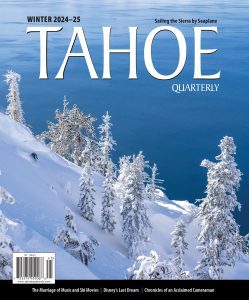
No Comments